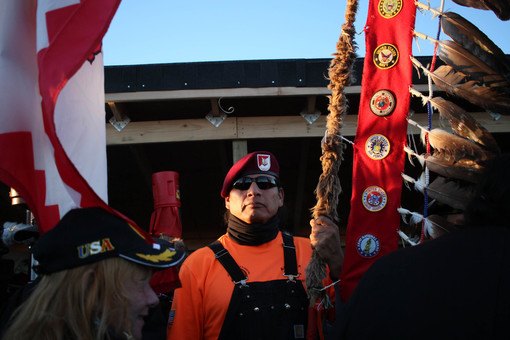The Sustaining Fires of Standing Rock: A Movement Grows
TRANSCEND MEMBERS, 20 Mar 2017
16 Mar 2017 – Over the past year, a remote area of North Dakota has been the improbable and prophetic site of a struggle with profound ramifications for us all. The confrontation has pitted the Water Protectors — the Standing Rock Sioux, other Native American tribes, and their allies — against the oil profiteers of Texas-based Energy Transfer Partners. The source of conflict is completion of the $3.8 billion, thousand-mile Dakota Access Pipeline — the Black Snake — that Energy Transfer Partners has built to carry fracked oil from North Dakota to Illinois.
The current planned route for the pipeline takes it beneath the Missouri River treacherously close to the Standing Rock and other Sioux reservations. A serious leak will threaten the water supply of these tribes and millions of people who live further downstream. Meanwhile, pipeline construction has already caused irreparable harm to Native American ancestral burial grounds and sacred sites.
The Water Protectors
Beginning last April, Water Protectors from across the country — indigenous and non-indigenous alike — began to gather in the thousands at the Oceti Sakowin Camp, established just north of the Standing Rock reservation. Around the camp’s sacred fires, they shared and honored the rituals, stories, and principles of community fundamental to the traditional values of the Lakota tribes: prayer, respect, compassion, honesty, generosity, humility, and wisdom.
At the same time, the Water Protectors sought to block construction of the final section of pipeline. Their non-violent acts of civil resistance were met with attack dogs, tear gas, pepper spray, rubber bullets, percussion grenades, water cannons, aerial surveillance, and hundreds of arrests by militarized law-enforcement personnel. The standoff ended a few weeks ago when the Governor of North Dakota, citing safety concerns, issued an emergency evacuation order. Shortly thereafter, authorities forcibly shut down and razed the camp.
Assaults like those that took place at Standing Rock are really nothing new for our nation’s Native peoples. Their history of removal, dispossession, degradation, attempted forced assimilation, and betrayal at the hands of White America runs as long and as deep as the Missouri River itself. Spanning centuries, these experiences form a chronicle of unresolved grief and historical trauma, which Maria Yellow Horse Brave Heart has described as “the cumulative emotional and psychological wounding over one’s lifetime and from generation to generation following loss of lives, land, and vital aspects of culture.”
The consequences of these brutal colonization practices are visible too in a range of cold, hard statistics. Today Native Americans have a median household income barely two-thirds that of the general population, and their poverty rate is nearly twice as large. They’re half as likely to have a college degree, and their life expectancy is six years shorter. They also suffer from higher rates of alcoholism, drug abuse, incarceration, depression, and PTSD, as well as suicide among their youth.
The survival of Native Americans, their diverse communities, and their rich cultures — despite hardship and oppression, and against such long odds — is a powerful testament to their extraordinary resilience. This abiding strength deserves greater recognition than it receives; like historical trauma, it too is transmitted across lives and generations. Shared narratives, traditional practices, spiritual teachings, the prayerful appreciation of time and place, and respect for the interconnectness of all things serve as crucial protective factors for indigenous tribes and their members.
The Oil Profiteers
Compared to the Water Protectors who converged at Standing Rock, corporate oil profiteers are a very different breed. But they too have their sacred places: anywhere fossil fuels can be extracted from the ground at a handsome profit. They have rituals too: board meetings where successful ventures are celebrated and forays for new plunder are devised. And, of course, they have their own cherished stories: about the day they first struck it rich; or the time they duped a community into believing that fracking is risk-free; or the shrewd business deal that bankrupted their competition.
We shouldn’t be surprised by this contrast in cultural values. After all, consider the company profile for Energy Transfer Partners. Among its top institutional owners is Goldman Sachs, once famously described as “a great vampire squid wrapped around the face of humanity, relentlessly jamming its blood funnel into anything that smells like money.” Donald Trump — “I don’t believe in climate change” — was himself a high-profile investor until conflict-of-interest controversies during his presidential campaign reportedly forced him to sell his holdings. Former Texas Governor Rick Perry was on the company’s board of directors until earlier this year. Perry’s response to the catastrophic BP oil rig explosion in the Gulf of Mexico — ruled “gross negligence” and “willful misconduct” by a federal judge — is memorable in its own right: “There are going to be things that occur that are acts of God that cannot be prevented.”
And above all there’s Kelcy Warren, the multi-billionaire CEO of Energy Transfer Partners. His business philosophy is dog-eat-dog survival of the fittest, as he once explained this way: “Like Mother Nature, the energy industry purges itself now and then. …I don’t wish any negatives on my friends, but the most wealth I’ve ever made is during the dark times.” So where was Warren while the Standing Rock Sioux and their allies were braving “dark times” during a bitter North Dakota winter in makeshift huts and tipis? He was probably more than comfortable in his 23,000 square-foot home on ten acres in Texas, with six bedrooms, 13 bathrooms, and “a chip-and-putt green, a pole-vault pit, a four-lane bowling alley, and a 200-seat theater.”
A Movement Grows
Energy Transfer Partners boasts that the nearly completed pipeline utilizes state-of-the-art safety measures. But comparable pledges have preceded other environmental disasters in the past. The Water Protectors also recognize that these assurances are essentially meaningless for another reason: any construction that encourages continued reliance on fossil fuels is inherently dangerous and potentially calamitous for the Earth and future generations. The world’s leading scientists long ago reached an overwhelming consensus that climate change and global warming are the result of human activity — especially the burning of coal, oil, and natural gas — and that among the adverse consequences are more destructive floods, hurricanes, heat waves, droughts, and wildfires.
The oil profiteers know this too, but they have hundreds of billions of dollars in annual profits at stake, and large shareholders who vigilantly watch the bottom-line. So greed overwhelms conscience and they resort to false-alarm mind games as part of a massive misinformation campaign, insisting that warnings of planetary peril are vastly overblown. Favorite appeals in their propaganda arsenal include disingenuous denials that climate change exists; bogus claims that scientists disagree about the facts; unfounded assertions that there’s no crisis because we’re capable of adapting to change; and deceitful efforts to portray environmentalists as radical extremists.
Three days after last November’s election, CEO Kelcy Warren was confident about the prospects for the Dakota Access Pipeline: “They will not stop our project. That’s naïve. They’re not stopping our project.” Such arrogance seems to come naturally to someone who’s grown accustomed to relying on friends in high places and his personal wealth — he gave over $100,000 to Trump’s campaign — to achieve self-aggrandizing goals. The words of Dave Archambault II, chairman of the Standing Rock Sioux, communicate humility instead: “We have no power…the only thing that we have is support from around the world.”
But this support and solidarity shouldn’t be underestimated. Regardless of the pipeline’s final disposition in the federal courts, Energy Transfer Partners and its cronies have unleashed a counterforce that may well exceed their comprehension and control. While digging for dollars they’ve awakened a movement that combines a long-overdue commitment to addressing the trampled rights of Native Americans with a reinvigorated call for climate justice and environmental action. Today the ranks of the Water Protectors present at Standing Rock have been thinned. But as spring soon arrives on the North Dakota plains, countless more of us are embracing their powerful message of reverence and resistance.
_________________________________________
 Roy Eidelson is a member of the TRANSCEND Network and was a member of the American Psychological Association for over 25 years, prior to his resignation. He is a clinical psychologist and the president of Eidelson Consulting, where he studies, writes about, and consults on the role of psychological issues in political, organizational, and group conflict settings. He is a past president of Psychologists for Social Responsibility, associate director of the Solomon Asch Center for Study of Ethnopolitical Conflict at Bryn Mawr College, and a member of the Coalition for an Ethical Psychology. Roy can be reached at reidelson@eidelsonconsulting.com.
Roy Eidelson is a member of the TRANSCEND Network and was a member of the American Psychological Association for over 25 years, prior to his resignation. He is a clinical psychologist and the president of Eidelson Consulting, where he studies, writes about, and consults on the role of psychological issues in political, organizational, and group conflict settings. He is a past president of Psychologists for Social Responsibility, associate director of the Solomon Asch Center for Study of Ethnopolitical Conflict at Bryn Mawr College, and a member of the Coalition for an Ethical Psychology. Roy can be reached at reidelson@eidelsonconsulting.com.
Go to Original – counterpunch.org
DISCLAIMER: The statements, views and opinions expressed in pieces republished here are solely those of the authors and do not necessarily represent those of TMS. In accordance with title 17 U.S.C. section 107, this material is distributed without profit to those who have expressed a prior interest in receiving the included information for research and educational purposes. TMS has no affiliation whatsoever with the originator of this article nor is TMS endorsed or sponsored by the originator. “GO TO ORIGINAL” links are provided as a convenience to our readers and allow for verification of authenticity. However, as originating pages are often updated by their originating host sites, the versions posted may not match the versions our readers view when clicking the “GO TO ORIGINAL” links. This site contains copyrighted material the use of which has not always been specifically authorized by the copyright owner. We are making such material available in our efforts to advance understanding of environmental, political, human rights, economic, democracy, scientific, and social justice issues, etc. We believe this constitutes a ‘fair use’ of any such copyrighted material as provided for in section 107 of the US Copyright Law. In accordance with Title 17 U.S.C. Section 107, the material on this site is distributed without profit to those who have expressed a prior interest in receiving the included information for research and educational purposes. For more information go to: http://www.law.cornell.edu/uscode/17/107.shtml. If you wish to use copyrighted material from this site for purposes of your own that go beyond ‘fair use’, you must obtain permission from the copyright owner.
